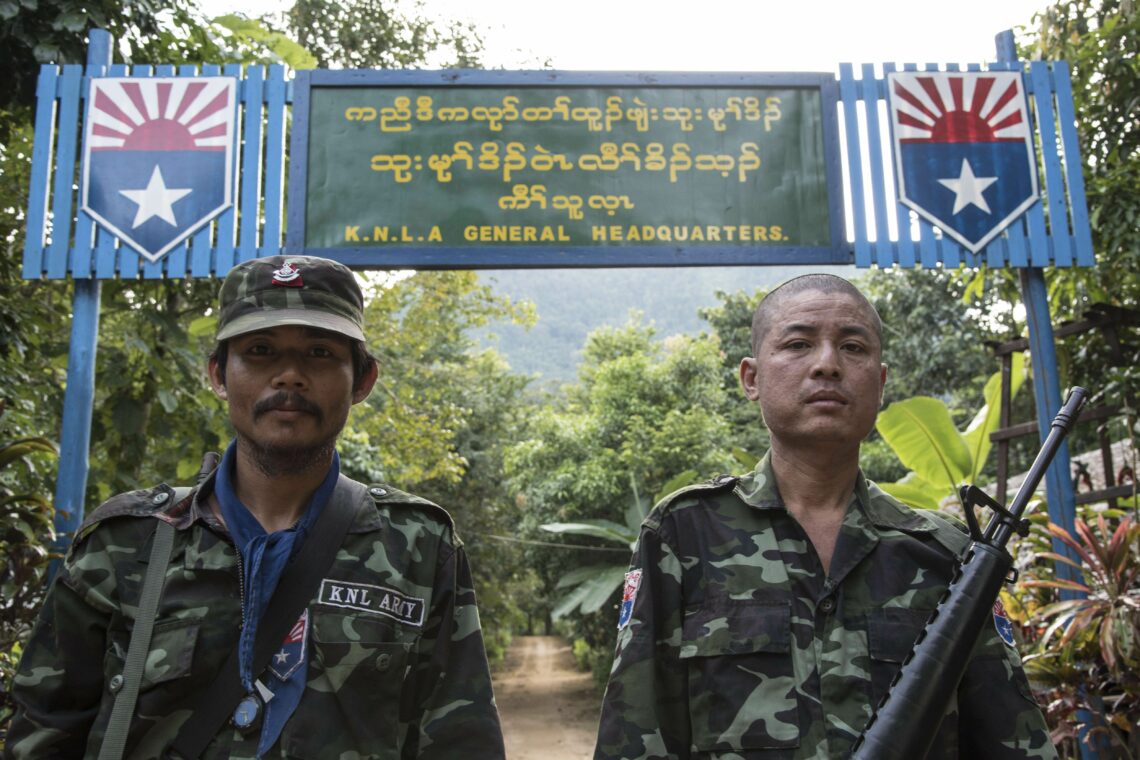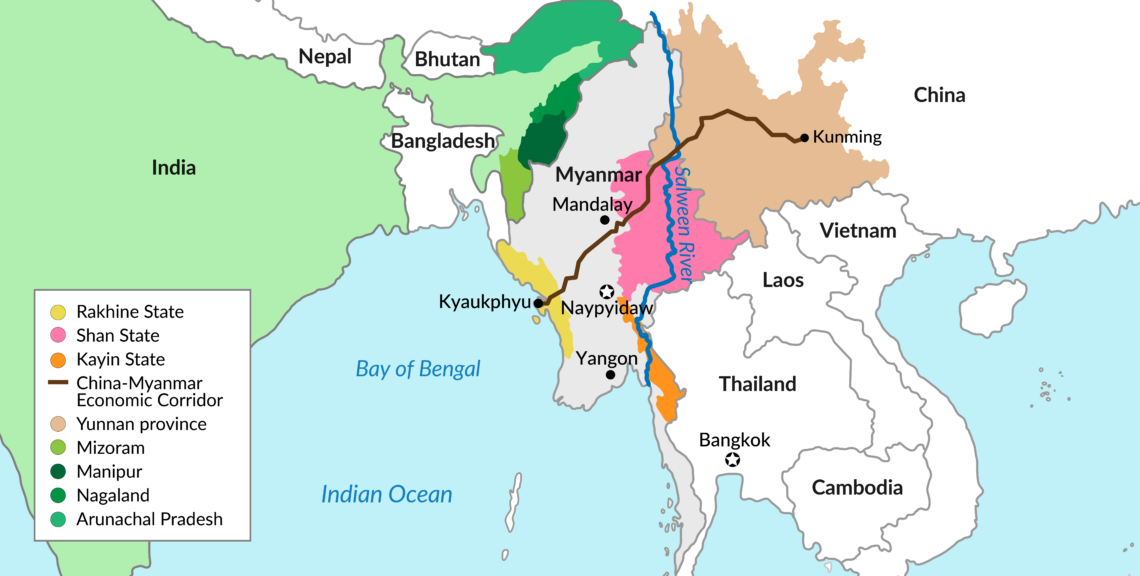Prospects for civil war in Myanmar
The ongoing conflict in Myanmar has raised the specter of a full-blown civil war. As the country’s neighbors watch the instability unfold and consider whether to get involved, the potential for a larger, more protracted conflict increases.

In a nutshell
- Myanmar’s military regime risks being stretched thin
- Armed ethnic groups could take advantage of the coup
- In case of a civil war, neighboring countries could get involved
Following the February 1, 2021 military coup in Myanmar, international commentators and the United Nations have warned of civil war. Ongoing conflict and escalating violence in Myanmar have now become an existential question for the military junta. As this phase of civil strife intensifies, assorted military factions and ethnic armed organizations (EAOs) on Myanmar’s periphery are assessing their future. The prospects include the downfall of the country’s military, the Tatmadaw, and Myanmar’s descent into full-blown domestic warfare.
Spillover effect
With 135 officially recognized ethnic groups and 20 EAOs representing about a third of the population, Myanmar’s ungoverned spaces will become a conduit for displaced people fleeing violence and famine. The outflow will exert pressure on India, China and Thailand, as well as Bangladesh, a country already struggling to handle the aftermath of the 2017 ethnic cleansing of the Rohingyas in neighboring Rakhine State. Conflict spillover has therefore become a key concern for the region, with consequences for big and small neighbors alike.
The most powerful EAOs, the Karen National Union (KNU) and the Kachin Independence Army (KIA), have attacked and overrun Tatmadaw outposts on Myanmar’s border with China and Thailand. These groups and other smaller ethnic fighting factions amount to a fighting force of about 80,000 compared to the Tatmadaw’s 350,000 troops.
China and India may mount operations to secure their borders and strategic interests.
Compounding the problem, coup leaders face troop deployment pressures on two fronts, the “domestic” front – the junta’s crackdown against the protest movement in the Burmese heartlands – and growing instability in the border regions. If EAOs in those regions decide to seize the moment while insurrection rages in Burmese urban centers, the Tatmadaw may be stretched thin in attempting to combat insurgencies on the periphery. In this scenario, strategic rivals China and India may mount operations to secure their borders and strategic interests in Myanmar.
U.S., the West and ASEAN
For the Biden administration, condemnation of the Myanmar coup is uncomplicated by comparison to the 2014 military coup in Thailand, where the Pentagon enjoys close ties with the Thai military establishment. The United States has already applied sanctions on the junta and will be working with friends and allies to isolate the regime.
A new sanctions regime imposed by Western countries will have limited effect. Regional countries like Singapore with significant investments in Myanmar, while openly condemning the killing of innocent civilians, are reluctant to support far-reaching international sanctions. Similarly, the coup has posed a severe challenge to the centrality of the Association of Southeast Asian Nations (ASEAN) in regional diplomacy.
ASEAN neighbors are accustomed to direct consultation with the Tatmadaw on questions of regional security. However, the creation of a parallel government representing Aung San Suu Kyi’s National League for Democracy (NLD) poses a dilemma for the organization. While the security of Myanmar’s periphery deteriorates rapidly, the prospect for another humanitarian disaster becomes more likely. ASEAN’s impotence will be in plain view of the international community.
China’s role
The Chinese government has not been vocal about the growing instability of its southwestern neighbor, calling only for a cessation of violence. Chinese Foreign Ministry statements have called for all sides to de-escalate but have not elaborated on the possibility of civil war in Myanmar. Beijing must be careful to avoid deviating from its long-standing insistence on noninterference, but Chinese restraint will be tested given the close links between the Tatmadaw, the People’s Liberation Army (PLA) and the large Chinese business community, especially in Mandalay. Several Chinese factories have already been destroyed by protesters.
Any further revelations of China’s complicity will fuel vehement anti-Chinese sentiment. Rumors among the opposition movement about ongoing night flights between Yangon and Kunming, the capital of China’s neighboring Yunnan province, appear to be true. These may be flights evacuating Chinese nationals from Myanmar, but there is speculation on what is on the return flights, including allegations that Chinese weaponry and ammunition used to suppress civil insurrection is being flown into Myanmar.
Facts & figures

Another cause for concern in Beijing is the resonance of the civil disobedience movement in Myanmar with similar movements in Thailand, Hong Kong and Taiwan. Myanmar’s younger generation protesters are now part of a broader pan-Asian democracy movement, the “Milk Tea Alliance.” China has always been concerned about “color revolutions” on its periphery and will be watching the development of the democracy movement closely for any signs of cross-border contagion.
A third concern for Beijing is the cross-border links between China-affiliated armed groups (including the 30,000-strong United Wa State Army, which runs a narco-state in Myanmar’s northeast) and organized crime syndicates in Yunnan province. Chinese authorities are deeply concerned about human trafficking, drug smuggling, arms dealing and illegal gambling operations across its border. Similar concerns are shared further south, along on the border with Shan State, where the ethnic Chinese Kokang militia operates. A 2015 conflict between the Tatmadaw and the Kokang Myanmar National Democratic Alliance Army (MNDAA) resulted in 40,000 members of the Kokang minority crossing the border to seek sanctuary in China.
Beijing’s patience was tested when Tatmadaw artillery fire strayed across the border, injuring several Chinese locals. In an unusual show of force, China’s PLA mounted joint land and air military exercises to demonstrate its displeasure with the military leadership in Naypyidaw. If Myanmar disintegrates from the outside inward, Beijing may decide to deploy the PLA to intervene across the border to create a Chinese safe zone and may mount covert infiltration operations to secure its border with Myanmar.
India’s apprehension
The February coup has impeded India’s aspirations to return attention to its eastern flank. Traditionally, India had trained its geostrategic focus west – toward the threat from Pakistani militancy and further afield to the economic opportunity of the Middle East. In recent years, New Delhi recognized the need to turn the other direction. Initially, it implemented a “Look East” policy but did not devote much energy to the idea. With much fanfare, in 2014 Prime Minister Narendra Modi initiated a renewed drive to “Act East,” launching the policy during a visit to Naypyidaw itself that same year.
New Delhi sees its periphery falling into China’s sphere of influence.
New Delhi now fears that the international isolation of the Tatmadaw will push the junta straight into Beijing’s lap. Myanmar is a key hub for China’s Belt and Road Initiative, with the creation of the China-Myanmar Economic Corridor (CMEC) in 2018, connecting Kyaukphyu port with China’s southwestern Kunming Province via Mandalay. Its sister project, the China Pakistan Economic Corridor (CPEC) connects China’s far west with Gwadar port in the Gulf of Aden.
Following lethal clashes between China and India in Galwan and simmering tension at the tri-border junction in Arunachal Pradesh, New Delhi likely sees its western and eastern periphery slipping into China’s sphere of influence. Furthermore, fears of a maritime “string of pearls” – a series of Chinese-developed ports in the Indian Ocean – have been rekindled. If Myanmar’s junta offered the PLA Navy access to Kyaukphyu port, for example, it would fuel New Delhi’s anxiety over Chinese naval encroachment into the Bay of Bengal.
New Delhi now fears that the international isolation of the Tatmadaw will push the junta straight into Beijing’s lap.
Bordering four of India’s northeastern states, Mizoram, Manipur, Nagaland and Arunachal Pradesh, Myanmar shares a 1,650-kilometer border with India. The northeastern states are a sensitive region for New Delhi, harboring separatist movements and insurgencies. Historically, the region has served as a pressure valve for conflict in Burma and a destination for waves of refugees. Increasing numbers of conscientious deserters from the Myanmar Police Force are already sheltering in India’s border states with Myanmar, especially Mizoram. For the time being, the Indian government may tolerate smaller numbers of deserters. But if cross-border affinities develop to the point that the restive states become bases for insurgency inside Myanmar, and if such insurgent groups build links with militant Indian separatist movements, New Delhi will have little patience.
For example, the disruptive capability of Myanmar’s Arakan Army (AA) remains a key concern for India. The AA, a Buddhist militia active in Rakhine State, has over the last two years threatened cross-border infrastructure projects enhancing India’s connectivity with Southeast Asia via Myanmar.
Armed groups in border regions
The Tatmadaw’s conflict with the AA ended after the coup, but the group may join with other EAOs or pursue its own agenda. For the people of Rakhine State in Myanmar, civil war has plagued the region for more than two years. It has experienced fewer protests than the Bamar (ethnic Burmese) heartlands and its population may be reticent to commit to joining a broad resistance movement against the Tatmadaw, especially after years of internecine conflict there and the population of internally displaced people numbering in the tens of thousands. The junta’s State Administration Council (SAC) appears keen to move these people back into Rakhine State, largely against their wishes, since they fear returning to fields strewn with land mines. Meanwhile, the Tatmadaw has been reinforcing its presence in Rakhine State, fueling fears among its inhabitants that conflict will resume at any moment.
Ethnic groups, seeing the Tatmadaw’s crackdown in the hinterland, do not accept the sincerity of the junta’s pledges.
In Myanmar’s Kayin (Karen) State, a seven-decade long conflict between Myanmar’s third-largest ethnic group and the Tatmadaw has flared up once again, creating a humanitarian crisis with thousands of displaced people pleading for help from Thailand. Prime Minister Prayuth Chan-Ocha, himself the orchestrator of a military coup in Bangkok in 2014, has ordered his forces to prepare for an influx of refugees. The SAC had announced a pan-Myanmar one-month cease-fire in March which was not honored. Consequently, the Karen National Union (KNU), the political wing of the Karen independence movement, called for a military pressure campaign on the Tatmadaw amid mounting casualties from shelling in the region, which escalated at the end of 2020.
As air strikes continued to terrorize the population there, the Karen National Liberation Army (KNLA) launched a raid against a remote military post on the Thai-Myanmar border, overrunning the Tatmadaw position. The Tatmadaw has launched retaliatory operations against the KNLA, prompting displaced Karens – numbering close to 10,000 – to escape across the Salween River into Thailand. Thai authorities face their own internal displacement problem in the border region as their citizens flee the conflict. They have attempted to restrict access there, but the wider implication is that Thailand’s own military-dominated regime will adopt a heavy-handed approach to tension on its border with Kayin State.
Outlook
Former State Counsellor Aung San Suu Kyi’s political allies have challenged the writ of the Tatmadaw’s SAC by establishing the Committee Representing Pyidaungsu Hluttaw (CRPH), aiming to promote a joint vision with Myanmar’s ethnic groups and to create a parallel National Unity Government as well as a federal army. The junta’s leader, General Min Aung Hlaing, has attempted to bring the AA and other EAOs into the Tatmadaw’s sphere of influence by creating peacemaking committees and offering them representation on the SAC.
However, it is now evident that the ethnic groups, seeing the Tatmadaw’s crackdown in the hinterland, do not accept the sincerity of Min Aung Hlaing’s pledges and are leaning toward the National Unity Government. If the assorted EAOs do coalesce into a credible challenge to an embattled Tatmadaw, civil war in Myanmar may become inevitable.
The Tatmadaw’s inability to control the activities of EAOs within and immediately across its borders will likely have far-reaching political, security and humanitarian implications for neighboring countries. New Delhi and Beijing are watching developments in Myanmar with mounting concern as they assess options to contain the spillover. If the EAOs supplant the Tatmadaw, a protracted and withering civil war may ensue in Myanmar.








